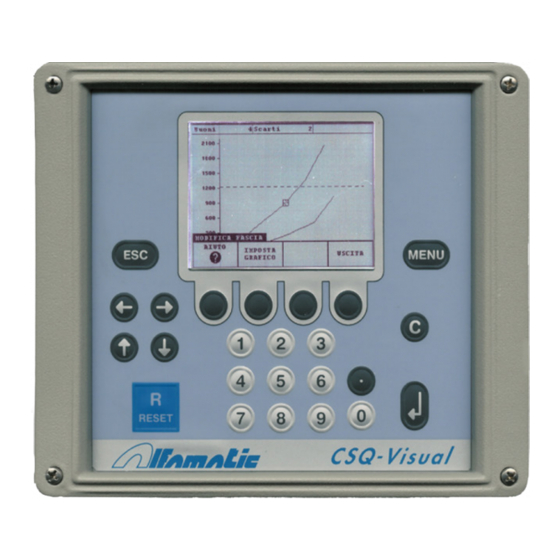
ALFAMATIC CSQ-Visual Installation Manual
Version with vio9 card
Hide thumbs
Also See for CSQ-Visual:
- Installation manual (14 pages) ,
- User manual (46 pages) ,
- Installation manual (16 pages)
Table of Contents
Advertisement
Quick Links
Advertisement
Table of Contents

Subscribe to Our Youtube Channel
Summary of Contents for ALFAMATIC CSQ-Visual
- Page 1 CSQ-Visual Version with VIO9 card Installation manual Mar. 7, 2017...
-
Page 3: Table Of Contents
Operating of the instrument ......................4 Internal cards............................ 5 Electric wiring........................... 5 Special functions ........................12 Configure automatic work selection ..................... 12 Configuring the use of the phases....................13 Connection of an external reset ..................... 14 SETPOINT output.......................... 14 Instructions for setting up the CSQ-Visual................15... -
Page 4: Installing Csq-Visual
This paragraph describes the operations necessary to fit and connect the CSQ-Visual to the machine and make it operative. The CSQ-Visual has been designed to be independent: all you have to do is connect the valves and sensors that will be powered by the instrument. Naturally there’s nothing to stop you from combined use with a PLC. -
Page 5: Internal Cards
1.4.1 Information for connection to an external controller (PLC) To connect the CSQ-Visual to a PLC, the latter must have PNP positive logic. The inputs and outputs of the instrument are optoinsulated from the instrument’s control electronics. The power supply of the instrument’s inputs and outputs must be the same that powers the inputs and outputs of the PLC. - Page 6 X18. The numbers are also printed on the printed circuit of the card. Figure 1 Main power terminal block (X24) The electronics of the CSQ-Visual and the transducers are powered at 24VDC via the X24 three- pole terminal block. Name Function...
- Page 7 Inputs terminal block (X3) The inputs are optoinsulated and compatible with clean contact signals or 24 VDC PNP transistor outputs. Name Terminal Default Input 0 X3.1 START Input 8 X3.2 Input 1 X3.3 T.D.C.(1) Input 9 X3.4 Input 2 X3.5 Input 3 X3.6 Input 4...
- Page 8 Control for electric lock lever on mechanical presses OPEN GREEN BOX Command for opening basket of the good pieces CLOSE PK TANK Closing command of the tank on the Alfamatic PK cilinders BLOCK OF THE TABLE Block piece for work PULL LEVER...
- Page 9 Transducer input terminal block (X12) An incremental encoder and a 0-10V signal can be connected to the X12 terminal block. A 12VDC or 5VDC power supply is available for the encoder (jumper J3). A very high-precision 10VDC power supply is available for the potentiometer. Name Terminal Description...
- Page 10 Analog input type on X11 Load cell 2mV/V supply 10V push only * Load cell 2mV/V supply 10V push pull OUT OUT Load cell 2mV/V supply 5V push pull OUT OUT Analog input 0-10V Analog input 0-5V * default Typical connection...
- Page 11 Optional connector D-Sub RS232 The RS232 pinout: Pin 2: RX interface input signal to the CSQ-Visual. Pin 3: TX interface output signal from the CSQ-Visual. Pin 5: GND Optional analog outputs (X16) Nome Morsetto Descrizione CLK+ X16.1 Do not connect CLK- X16.2...
-
Page 12: Special Functions
2 Special functions 2.1 Configure automatic work selection The CSQ-Visual supports the automatic selection of work using the combination of the inputs or a command sent to the serial port. This selection can be useful for automatically recognising the piece or the tool fitted. -
Page 13: Configuring The Use Of The Phases
The CSQ-Visual is able to manage up to four phases for each single process. The choice of the phase may take place automatically, in succession or through the digital inputs of the instrument. -
Page 14: Connection Of An External Reset
PNP (positive logic) output. 2.4 SETPOINT output The CSQ-Visual has an auxiliary output which can be activated when a determined absolute position or a determined force have been reached. The value of this position or force of the setpoint can be different for every single work. -
Page 15: Instructions For Setting Up The Csq-Visual
3 Instructions for setting up the CSQ-Visual Always disconnect the instrument from the electricity supply before opening it. Open the CSQ-Visual by loosening the four screws in the corners of the front panel. Figure 3 Pull out the internal cards by a few centimetres. Then release the cards from the front panel. - Page 16 Figure 5 Slot the wires through the wire passage and start wiring. It is extremely important for the end of the wire of the load cell which is not covered by a sheath to be as short as possible After completing the wiring, insert the card Lastly, insert the terminal block units, paying attention to the direction.










Need help?
Do you have a question about the CSQ-Visual and is the answer not in the manual?
Questions and answers